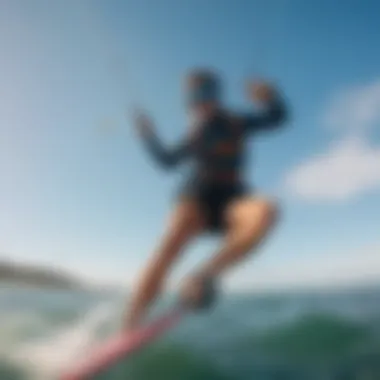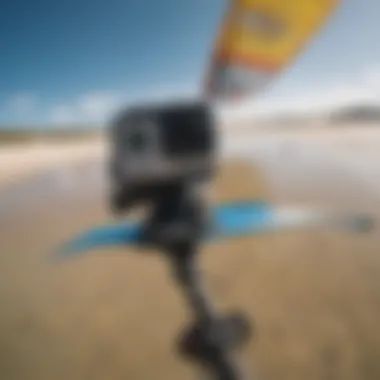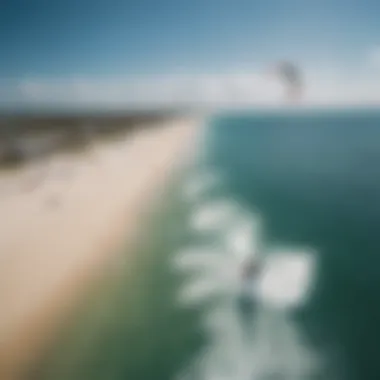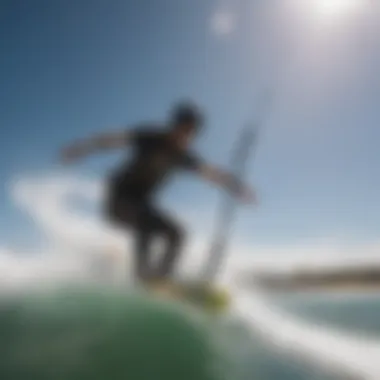Capturing Kiteboarding Thrills with GoPro Cameras


Intro
Kiteboarding is not just about skill and adrenaline; it’s also a great way to tell a story through visuals. With the rise of action cameras like GoPro, capturing breathtaking moments on the water has never been easier. This section will delve into various aspects of kiteboarding filming, focusing on how to effectively mount and manage your GoPro for the best results.
The beauty of kiteboarding lies in its dynamic nature, combining the thrill of wind, water, and skillful maneuvers. But how do you capture that essence while ensuring your footage stands out? In this article, we'll explore important techniques, gear reviews, and editing tips designed for all levels of kiteboarders—whether you’re just getting your feet wet or soaring high with advanced freestyle moves.
Transitioning from the thrill of riding to the art of filming requires some finesse, and that’s precisely what we aim to provide. Let’s take a look at how we can beautifully showcase your kiteboarding adventures, thus enhancing not just your own experience, but also sharing those moments with others.
Techniques
Capturing high-quality footage while kiteboarding necessitates an understanding of both the sport and the equipment. Here, we'll discuss various techniques that kitesurfers can adopt, categorized into beginner methods and advanced maneuvers.
Beginner Kiteboarding Techniques
For novices, the focus should be on stabilization and creativity. Here are some simple strategies for getting started:
- Camera Placement: Mount the GoPro on the board or helmet to get a feel for the perspective. A low angle can highlight your board and give a sense of speed.
- Simple Movements: While mastering tricks is important, don’t underestimate the beauty of a smooth ride across the water. Sometimes, the most mesmerizing shots come from basic dives and turns.
- Use of Natural Light: For beginners, film during the golden hours — early morning or late afternoon — to take advantage of stunning lighting, which can make even the simplest footage look breathtaking.
Advanced Freestyle Maneuvers
Once comfortable with the basics, enthusiasts can branch out and explore advanced techniques that highlight more dynamic aspects of kiteboarding:
- Dynamic Camera Angles: Experiment with mounting the GoPro on the kite itself for a unique aerial perspective, or try using follow-cams for a close-up of the action.
- Editing Motion Shots: When capturing high jumps or flips, multiple angles can make the final edit look seamless. Make sure to use a variety of mounts plus post-production tools to stitch together eye-catching sequences.
- Storytelling: Integrate shots of your preparation and ambiance. This adds context and keeps viewers engaged beyond just action shots.
Gear Reviews
The right gear can make a world of difference in kiteboarding filming. Here’s an overview of some key items that kiteboarders may find essential when capturing their experiences.
Latest Kiteboarding Equipment
In the ever-evolving world of kiteboarding, staying updated with the latest equipment remains constructive:
- Kites: Invest in a quality kite such as the Duotone Neo for great performance.
- Boards: The Slingshot Terrain delivers stability and grip, ideal for capturing high-quality footage while riding.
- Harnesses: A good harness fits comfortably and securely, allowing for a full range of movement needed for filming.
Essential Accessories for Kiteboarders
Accessories can substantially boost your filming experience. Here’s a list:
- GoPro Mounts: A variety of mounts like the chest or helmet mount can offer different filming perspectives.
- Waterproof Housing: An essential for protection against splashes, maximizing the lifespan of your camera.
- Extra Batteries and Memory Cards: Recording high-definition footage can quickly drain your resources, thus coming well-equipped ensures you don’t miss a moment.
Remember, the key to great kiteboarding footage isn’t just the equipment. It also lies in how you use it.
As we venture further into this guide, it will cover essential editing skills and tips on sharing your remarkable footage, making your kiteboarding stories come alive in ways your friends will be talking about for ages.
Prelims to Kiteboarding and GoPro
Kiteboarding has surged in popularity over the past few decades. The thrill of harnessing wind power while gliding across water captures the imagination of thrill-seekers worldwide. But there's more to kiteboarding than just the exhilarating ride; it’s about sharing experiences and creating lasting memories. This is where the magic of GoPro comes in. GoPro cameras have revolutionized how adventure enthusiasts document their escapades, bringing the adrenaline rush to life through vivid visuals.
The Rise of Kiteboarding
In a world where extreme sports are captivating audiences, kiteboarding stands out with its unique blend of surfing, wakeboarding, and paragliding elements. It began gaining traction in the late '90s and, with the advent of specialized equipment, has only grown in appeal. Enthusiasts flock to picturesque coastlines, chasing the wind not just for sport, but for the unmatched joy of balancing on a board while being pulled by a kite.
As kiteboarding continues to mature, its community grows alongside it. Social media plays a vital role in promoting the sport, where kiteboarders share breathtaking footage of themselves conquering waves or executing high-flying stunts. This visual storytelling not only inspires budding kiteboarders but also fosters an environment where shared experiences elevate the entire kiteboarding community.
GoPro's Role in Action Sports
GoPro cameras have positioned themselves as the go-to device for capturing action sports. Their compact size and durable design make them ideal for recording dynamic experiences without getting in the way. For kiteboarders, this means the ability to mount a camera on the kite, the rider, or the board itself, capturing perspectives that showcase the beauty and power of the sport.


The importance of GoPro in kiteboarding cannot be overstated. It allows riders to document their journeys, pushing the boundaries of traditional filming. Gone are the days of merely recounting tales of daring exploits; with a GoPro, these adventures can be viewed first-hand, putting everyone in the heart of the action.
"With every session, a kiteboarder has a tale to tell, but capturing it on video? That’s where storytelling really comes alive."
Not only does GoPro provide an avenue for personal expression, but it also creates a wealth of content perfect for sharing across multiple platforms. These visuals foster engagement and connection within the kiteboarding community, with each clip telling a story of its own, full of thrills and breathtaking moments.
The Technical Aspects of Camera Mounting
When it comes to taking breathtaking footage in kiteboarding, the technical aspects of camera mounting are crucial to the success of your filming endeavors. Capturing the perfect shot not only depends on your skills as a kiteboarder but also on how effectively you mount your GoPro. With a proper setup, you can achieve immersive perspectives that bring viewers right into the action.
Choosing the Right Mount
Selecting the right mount can make or break your filming experience. Numerous types of mounts are available, each offering unique advantages. One popular option is the helmet mount, which provides a direct first-person view. It’s ideal for a thrilling, rider-centric perspective. Alternatively, a chest mount offers a stable shot that showcases your movements alongside the board.
When considering where to attach your GoPro, factor in the following:
- Environment: Some mounts work better in specific conditions. For example, a kite mount captures aerial views that are stunning during high winds.
- Stability: A secure mount reduces vibrations, resulting in smooth footage. A shaky video can distract from the beauty of the sport.
- Accessibility: Ensure the mount is easy to adjust, allowing you to switch angles quickly if necessary.
Choosing the right mount isn’t just about preference; it’s about enhancing your storytelling through dynamic visuals.
Placement Techniques for Optimal Angles
Placement can be the secret ingredient to vibrant and captivating footage. Positioning your camera at various angles not only enriches the storytelling aspect but also caters to different viewer experiences. Here are some techniques to consider:
- Low Angle Shots: Mounting the camera close to the water will capture the dynamic interactions between the board and the surface, highlighting the thrill of each ride.
- High Perspective: A higher mount provides a broad view of the environment, capturing sea, sky, and kite in one sweeping shot.
- Dynamic Transitions: Changing camera placement between each run can create a more engaging narrative. Experiment with different setups throughout your session.
An effective use of placement is all about creativity. Don’t hesitate to try something unconventional to find what works best for you.
Considerations for Different Kite Types
Different kite types can require varying camera approaches. For instance, a freestyler's kite may have faster movements during aerial tricks, needing a mount that minimizes vibrations and captures quick changes in direction. Conversely, a wave rider may favor stability over angle complexity, focusing on capturing the seamless glide across water.
Here are some points to ponder when filming with different kites:
- Kite Size: Larger kites can create more turbulence, so a more stable mount will help maintain smooth footage.
- Riding Style: Your technique will affect footage. If you’re performing tricks, prioritize angles that highlight your moves, while cruising might call for broader shots.
- Weather Impact: Wind conditions can differ with kites, leading to unpredictable movement of the camera. Awareness of how these elements interact will aid in more successful filming.
Remember, the better your setup and understanding of the kite's dynamics, the more effective your footage will be.
In summary, effective camera mounting in kiteboarding hinges on the careful selection of mounts, optimal placement techniques, and an understanding of the kite dynamics. These components work together harmoniously to elevate not only the visuals captured but the entire storytelling experience.
Understanding Kite Dynamics in Filming
When diving into the world of kiteboarding, one cannot overlook the pivotal role that kite dynamics play in the storytelling process through filming. Being aware of how a kite behaves in various wind conditions seems trivial, but it can make or break the footage you aim to capture. It’s not just about having the latest GoPro; it’s about understanding the sport itself and how the kite interacts with the environment. This knowledge allows you to capture breathtaking moments and manage the technical challenges that arise, making your footage worthwhile and impactful.
The Importance of Wind Conditions
Wind conditions can dramatically change the kite’s performance and, in turn, the footage captured. Strong winds can lead to exhilarating jumps and tricks, producing visually stunning results. However, they also come with risks of equipment failure or motion blur in filming. The thrill factor might spike, but understanding wind speed can help you gauge if it’s suitable for capturing high-quality video. For instance, filming during steady moderate winds is typically better for smoother shots.
Key Factors to Keep in Mind:
- Wind direction: Know how it affects your kite’s angle.
- Wind speed: Ideal ranges depend on kite size and rider skill.
- Variability: Wind gusts can alter your shot’s stability.
Managing Camera Motion
In kiteboarding, motion is inevitable. However, controlling that motion is an art and a science. Any shift in the kite’s position, even just a slight turn, can throw off the framing and focus of your shots. Think of it this way: if the camera isn't aligned with the kite's path, those breathtaking maneuvers may end up looking lackluster in the final product.
One popular strategy is to utilize a gimbal or stabilizer. These tools help counteract sudden movements while allowing for fluid transitions between shots.


Tips for Managing Camera Motion:
- Keep the camera low to the water for breathtaking perspectives.
- Use wide-angle lenses to minimize the impact of motion.
- Follow the kite, and anticipate its moves to stay ahead.
Enhancing Stability Despite Movement
Stability is paramount in kiteboarding filming, especially since the environment is anything but stable. Waves, gusts, and unpredictable aerial dynamics can wreak havoc on your footage. Hence, devising strategies to enhance stability is essential for achieving that polished look.
Using equipment like the GoPro Hero 9 or Hero 10, equipped with advanced stabilization features, can immensely help. Moreover, optimizing your settings based on the conditions can work wonders.
"Smooth footage is not just a bonus, it’s a requirement for telling a compelling story."
Here are a few techniques to improve stability:
- Utilize camera mounts designed for action shots.
- Experiment with different angle placements to find what works best with your kite style.
- Ward off shaky footage by filming at a higher frame rate and slowing down during editing.
Overall, understanding kite dynamics allows kiteboarders and filmmakers alike to craft compelling visual narratives that not only document action but also encapsulate the thrill and excitement of the sport. With the right knowledge and tools, the sky truly is the limit.
Common Challenges and Solutions
Kiteboarding is not just a thrill ride on water; it also offers unique opportunities to capture thrilling moments through the lens of a GoPro. However, capturing these thrilling moments is not a walk in the park. As the wind catches your kite and propels you across the water at exhilarating speeds, various challenges arise. Addressing these issues not only enhances your filming skills but also contributes significantly to the overall quality of your footage.
Dealing with Vibrations and Distortions
One of the most challenging aspects of kiteboarding filming is managing vibrations and distortions that can occur due to the dynamic nature of the sport. When you mount the GoPro on your board or helmet, even the tiniest bump or sway can result in shaky footage that detracts from the spectacular scenery you aim to capture.
To combat this, consider using a gimbal or anti-vibration mounts specifically designed for action cameras. These tools can help stabilize the footage by counteracting the motions caused by waves or wind. Also, make sure the camera is tightly secured; a loose mount can amplify vibrations significantly.
Aside from hardware, the video settings also play a pivotal role. Recording at higher frame rates might help in smoothing out the footage when editing, as it provides more frames to work with during post-production. However, be aware that this can lead to larger file sizes, so manage your memory cards accordingly.
Adjusting to Changing Weather Conditions
Kiteboarding is often more about embracing the elements rather than battling them. Weather conditions can shift rapidly, impacting both the kiteboarding experience and the filming timeline. From sudden gusts of wind to unexpected rain, successful filmmakers always have one eye on the sky.
When dark clouds approach or unpredictable winds pick up, it’s crucial to remain flexible. Adjust your filming techniques based on the changing conditions. For example, in cloudy conditions, consider leveraging your GoPro's settings. Opt for lower ISO levels to reduce noise in your footage, or use filters that help balance the exposure.
Additionally, invest in a water-resistant housing if you plan to film in rain or choppy waves. This not only protects your device but also opens up a world of unique filming opportunities that would otherwise be missed due to unfavorable weather.
"A true kiteboarder knows to nestle under the storm’s embrace rather than shy away from it. Bring that spirit to your filming, and you might just capture some of your best moments."
Ultimately, staying prepared and adaptable can make all the difference when you're out on the water. The better you are at adjusting to the elements, the more captivating your footage will become.
Editing Techniques for Captured Footage
When it comes to kiteboarding footage, editing can make or break the experience. After all, you could have the most stunning clips with impeccable angles, but if they’re poorly stitched together, it may lose its magic. Good editing transforms raw, shaky footage into a captivating narrative that resonates with viewers, making the experience immersive.
The importance of editing lies not just in enhancing the visual appeal but also in crafting a storyline. Your edits can evoke emotions, showcase the thrill of the sport, or highlight the serene beauty of being out on the water. Consider that not every segment you capture will be riveting. Being selective and intentional in editing ensures that only the best moments shine through.
Choosing the Right Editing Software
Selecting editing software is akin to choosing the right kite for your session—it needs to fit your style. There are numerous options available, each catering to different levels of expertise and specific needs.
- iMovie: Perfect for beginners, it provides an easy interface with basic functionalities to trim clips, add music, and employ simple effects.
- Final Cut Pro: A step up for more seasoned editors. It offers advanced features like multi-cam editing and extensive color correction tools but comes at a steeper price.
- Adobe Premiere Pro: A favorite among professionals. Its versatility allows significant flexibility and integration with other tools in the Adobe suite, although the learning curve is notable.
In choosing software, consider:
- Your own experience level
- Specific features you need
- Your budget


Cutting and Joining Clips Effectively
Editing is about rhythm as much as it is about visuals. Properly cutting and joining clips can create a smooth viewing experience that keeps the audience engaged. Start by analyzing your footage for dynamic moments that capture the essence of kiteboarding—fast turns, jumps, or serene sunset flights.
- Transitions: Use cuts that feel seamless. Avoid abrupt changes that disrupt the flow. Fade-ins and outs can be effective to transition between emotionally charged scenes.
- B-Roll: Incorporating supplementary footage can enrich your story. If you're featuring a jump, consider cutting to a close-up of the waves crashing or the sun shimmering on the water.
"Editing doesn’t just show the action; it tells a story that draws you in."
Enhancing Footage with Color Grading
After joining clips, color grading helps unify your footage. It’s about setting the mood—whether that’s the sharp, sun-drenched vibrancy of a summer's day or the serene pastel hues of a windy dawn. Color correction can make footage from different times or conditions feel cohesive, while grading can invoke the desired emotional response.
- Basic Techniques: Start with adjusting brightness and contrast to ensure each clip looks well-lit and true to what the eye sees.
- Color Wheels: These allow you to tweak shadows, midtones, and highlights, helping to bring out your desired aesthetic.
- LUTs (Look Up Tables): Pre-made LUTs can jumpstart your grading process. They provide instant looks but remember to customize to avoid a one-size-fits-all.
In summary, mastering editing techniques enhances your kiteboarding footage in significant ways. With the right tools and a creative approach, you’ll be able to share your thrilling experiences in a way that captivates and inspires others.
For further resources and community discussions on editing techniques, consider visiting reddit.com/gopro for insights from other enthusiasts.
Sharing Your Kiteboarding Experiences
In the realm of kiteboarding, sharing your experiences resonates just as loudly, if not louder, than the thrill of the rides themselves. Capturing adventures through video and sharing these moments not only enhances one’s personal enjoyment but also contributes significantly to the global kiteboarding community. By showcasing unique experiences, riders inspire others, encourage participation in the sport, and foster connections among enthusiasts, instructors, and marketers alike. Through thoughtful engagement, kiteboarders can elevate their narrative beyond just personal achievement.
Platforms for Distribution
When it comes to sharing your kiteboarding footage, the right platform can make all the difference. Various channels allow for wide reach and engagement, each suited to different kinds of content and audience expectations.
- YouTube: Renowned for hosting videos of all kinds, it’s the go-to place for longer films and tutorials. By optimizing keywords, descriptions, and tags, your videos can gain traction and visibility.
- Instagram: Perfect for bite-sized snippets, Instagram allows you to connect with viewers via Stories and Reels. The use of hashtags can amplify your reach to fellow kiteboarders and fans.
- Facebook: A robust platform for building community, sharing events, or even setting up groups dedicated to kiteboarding enthusiasts. Engagement through comments and shares can foster deeper connections.
- TikTok: Fast and vibrant, TikTok appeals to younger audiences who enjoy quick, entertaining clips. Trends often move swiftly here, so you can catch waves of engagement by being timely in your posts.
Each platform has its unique setting and advantages. Consider your goals: are you aiming for high engagement, detailed tutorials, or simply sharing breathtaking views? Tailoring your footage to the strengths of each platform is key.
Engaging with the Kiteboarding Community
Engagement with the kiteboarding community fuses enjoyment with education. It’s not merely about showcasing footage; there's value in mutual support and knowledge exchange. Sharing your experiences invites discussions that can lead to invaluable feedback. Participate in forums or social media groups—connect on Reddit, exchange ideas on Facebook, or even contribute to specialized kiteboarding forums. The wealth of insights from seasoned riders, instructors, and innovators can significantly enhance your skills and understanding.
Remember: The kiteboarding community thrives on collaboration. Your individual contributions help propel the sport forward, creating an environment where learning and passion unite.
In sharing, you also inspire others. Whether they are beginners or advanced riders, your footage and stories can spark curiosity, encourage exploration, and maybe even lead someone to try their hand at kiteboarding. Each experience shared is another thread woven into the rich tapestry of the kiteboarding world.
Thus, leveraging various distribution platforms while actively engaging with the community transforms individual rides into collective experiences, promoting growth within the sport and offering a supportive network for everyone involved.
Future Trends in Kiteboarding Filming
The world of kiteboarding capturing is on the cusp of revolution, driven by advancements in technology and evolving kite designs. Understanding future trends in kiteboarding filming is crucial for enthusiasts aiming to stay ahead of the curve. These trends not only enhance the visual storytelling aspect of kiteboarding but also offer fresh perspectives on the sport itself. Here, we explore emerging technologies and potential developments that kiteboarders should keep an eye on to elevate their filming game.
Emerging Technologies in Action Cameras
Recent years have seen a surge in the capabilities of action cameras, particularly from GoPro and other brands. These devices are becoming more sophisticated, boasting features that cater specifically to adrenaline-fueled sports like kiteboarding. For instance, improvements in low-light performance enable users to capture footage even during dawn or dusk sessions, adding a new dimension to storytelling.
Another significant trend is the integration of AI technology. Modern cameras can analyze the environment and automatically adjust settings to optimize footage quality. Users find this extremely beneficial when they are in the thick of action, as adjusting settings manually can be tricky.
Additionally, the use of dual-lens systems is gaining traction. These allow for 360-degree capturing, providing an immersive viewing experience that standard cameras can’t match. Now, viewers can see the action unfold from all angles, making for an engaging storytelling medium.
As you navigate through kiteboarding adventures, having reliable technology at your side will not just help in capturing the thrill but in sharing it in ways that draw audiences in like never before.
Potential Developments in Kite Design
While the action camera technology is important, changes in kite design can fundamentally alter how artists and storytellers capture their adventures. The next wave of kite design focuses on enhancing functionality without compromising on performance. For instance, increased adaptability is a hot topic; this allows riders to use kites in a wider range of wind conditions, thus expanding filming opportunities.
In the future, we might see kites equipped with built-in camera mounts or lightweight materials that blend durability with adaptability. This innovation would render the process of filming hassle-free. Imagine a scenario where a kite can not only perform on the water but also serve as a filming rig with minimal extra effort.
Through shifting design paradigms, kiteboarding is set to evolve into a more dynamic and visually engaging sport. The interaction between advanced filming equipment and innovative kite designs will set a new standard for storytelling in kiteboarding, paving the way for a brighter visual narrative.
"Innovation in both camera technology and kite design will transform how we visualize and share our kiteboarding experiences. The future is bright for storytellers in this exhilarating sport."
Embracing these emerging technologies and design developments is vital for kiteboarders who wish to stand out. Understanding how these trends play into your shooting and sharing strategies will ensure that you not only catch the action but can also craft compelling stories that resonate with viewers across multiple platforms.







